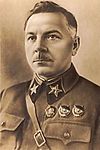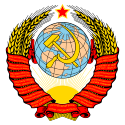- List of heads of state of the Soviet Union
-
Heads of state of the Union of Soviet Socialist Republics Former political post 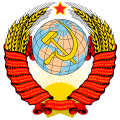
Coat of arms Predecessor None Successor President of the Russian Federation First officeholder Mikhail Kalinin Last officeholder Mikhail Gorbachev Official residence Moscow Kremlin Political office started 30 December 1922 Political office ended 25 December 1991 Current pretender Position abolished The Constitution of the Soviet Union recognised the highest organ of state authority in the Union of Soviet Socialist Republics (USSR) as the head of state. The Chairman of the Presidium of the Supreme Soviet, and the earlier office of Chairman of the Central Executive Committee (CEC) of the Congress of Soviets which was reorganised in 1938, had primarily only ceremonial powers.[1] While the head of state had many de jure powers, it had very few de facto ones.
The Soviet Union was established in 1922. However, the country's first constitution was adopted in 1924. Before that time, the 1918 Constitution of the Russian Soviet Federative Socialist Republic was adopted as the de facto constitution of the USSR. According to the 1918 Constitution, the All-Russian Central Executive Committee (CEC), chaired by the head of state, had the power to determine what matters of income and taxation would go to the state budget and what would go to the local Soviets. The CEC could also limit taxes.[2] In periods between convocations of the Congress of Soviets the CEC held supreme power.[3] In between sessions of the Congress of Soviets the CEC was responsible for all the affairs of the Congress of Soviets.[4] The CEC and the Congress of Soviets was replaced by the Presidium and the Supreme Soviet by several amendments to the 1936 constitution in 1938.[5]
The Supreme Soviet was the highest organ of state power, and was the sole organ to hold legislative power in the Soviet Union.[5] Sessions of the Supreme Soviet were convened by the Presidium twice a year; however, special sessions could be convened on the orders of a Union Republic.[5] In the events of a disagreement between the Soviet of the Union and the Soviet of Nationalities the Presidium could form a conciliation commission. If this commission failed the Presidium could dissolve the Supreme Soviet and order new elections.[5] The Chairman of the Presidium of the Supreme Soviet, along with first and fifteen other vice chairmen, were, according to the 1977 Soviet Constitution, elected by the deputies of the Supreme Soviet.[6] Just as with the CEC under Joseph Stalin's rule, the Chairman of the Presidium had very little de facto power after Stalin's death because supreme power was given to the leader of the Communist Party of the Soviet Union (CPSU).[7]
The Presidency was established in 1990 and would be, according to the altered constitution, be elected by the Soviet people by direct and secret ballot. However, the first President was elected by the democratically-elected Congress of People's Deputies.[8] In connection with the dissolution of the Soviet Union national elections for the office of President never took place. To be elected to the office a person must have been a Soviet citizen and older than thirty-five but younger than sixty-five years. The same person could not be elected president for more than two terms.[9] The Presidency was highest state office, and was the most important office in the Soviet Union by influence and recognition, eclipsing that of Premier and General Secretary. With the establishment of the Presidency executive power was shared between the President and the Prime Minister. The Presidency was given broad powers, such as being responsible for negotiating the membership of the Cabinet of Ministers with the Supreme Soviet;[10] the Prime Minister, however, was responsible for managing the nomenklatura and economic matters.[11]
Contents
List of heads of state
Of the eleven individuals appointed head of state, three of them died in office of natural causes (Leonid Brezhnev, Yuri Andropov and Konstantin Chernenko), two held the position in a temporary role (Vasili Kuznetsov and Gennady Yanayev), and four held posts of party leader and head of state simultaneously (Brezhnev, Andropov, Chernenko and Mikhail Gorbachev). The first head of state was Mikhail Kalinin, who was inaugurated in 1922 after the Treaty on the Creation of the USSR. At over twenty years, Kalinin spent the longest time in office; he died shortly after his resignation in 1946. Andropov spent the shortest time in office.
#
[note 1]Name
(birth–death)Portrait Term of office Convocations
[note 2]1 Chairman of the Central Executive Committee of the Congress of Soviets (1922–1938) Mikhail Kalinin
(1875–1946)[12]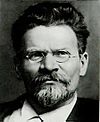
30 December 1922 – 12 January 1938 1st–8th Convocation Chairman of the Presidium of the Supreme Soviet (1938–1989) Mikhail Kalinin
(1875–1946)[12]
17 January 1938 – 19 March 1946 1st Convocation 2 Nikolay Shvernik
(1888–1970)[13]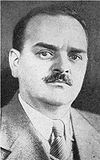
19 March 1946 – 6 March 1953 2nd–3rd Convocation 3 Kliment Voroshilov
(1881–1969)[14]15 March 1953 – 7 May 1960 3rd–5th Convocation 4 Leonid Brezhnev
(1906–1982)[15]
7 May 1960 – 15 July 1964 5th–6th Convocation 5 Anastas Mikoyan
(1895–1975)[16]
15 July 1964 – 9 December 1965 6th Convocation 6 Nikolai Podgorny
(1903–1983)[17]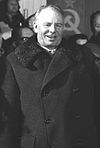
9 December 1965 – 16 June 1977 6th–9th Convocation 4 Leonid Brezhnev
(1906–1982)[15]
16 June 1977 – 10 November 1982 9th–10th Convocation — Vasili Kuznetsov
(1901–1990)[18]
10 November 1982 – 16 June 1983 10th Convocation 7 Yuri Andropov
(1914–1984)[19]16 June 1983 – 9 February 1984 — Vasili Kuznetsov
(1901–1990)[18]
9 February 1984 – 11 April 1984 11th Convocation 8 Konstantin Chernenko
(1911–1985)[19]
11 April 1984 – 10 March 1985 — Vasili Kuznetsov
(1901–1990)[18]
10 March 1985 – 27 July 1985 9 Andrei Gromyko
(1909–1989)[20]
27 July 1985 – 1 October 1988 10 Mikhail Gorbachev
(born 1931)[21]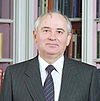
1 October 1988 – 25 May 1989 11th–12th Convocation Chairman of the Supreme Soviet (1989–1990)[note 3] Mikhail Gorbachev
(born 1931)[21]
25 May 1989 – 15 March 1990 12th Convocation President (1990–1991) Mikhail Gorbachev
(born 1931)[21]
15 March 1990 – 25 December 1991 12th Convocation List of vice heads of state
There have been five individuals appointed vice head of state. The first vice head of state was Nikolay Shvernik. At over eighth years, Vasily Kuznetsov spent the longest time in office. Gennady Yanayev spent the shortest time in office.
#
[note 1]Name
(birth–death)Term of office 1 First Vice Chairman of the Presidium of the Supreme Soviet (1944–1946/1977–1989) Nikolay Shvernik
(1888–1970)[23]1 February 1944 – 19 March 1946 2 Vasili Kuznetsov
(1901–1990)[18]7 October 1977 – 27 July 1985 3 Pyotr Demichev
(1917–2010)[24]18 June 1986 – 1 October 1988 4 Anatoly Lukyanov
(born 1930)[25]1 October 1988 – 25 May 1989 Vice Chairman of the Supreme Soviet (1989–1990) Anatoly Lukyanov
(born 1930)[25]25 May 1989 – 15 March 1990 — Vice President (1990–1991) Vacant 15 March 1990 – 27 December 1990 5 Gennady Yanayev
(1937–2010)[26]27 December 1990 – 21 August 1991[note 4] — Office abolished[28] 21 August 1991 – 26 December 1991[note 5] See also
- Soviet Union-related
Further information: Index of Soviet Union-related articles- Presidium of the Supreme Soviet
- Supreme Soviet of the Soviet Union
- List of leaders of the Soviet Union
- Premier of the Soviet Union
- List of Governments of the Soviet Union
- List of Spouses of Soviet heads of state
- General Secretary of the Communist Party of the Soviet Union
- Russia-related
- List of leaders of the Russian SFSR
- List of heads of government of Russia
- List of Presidents of the Russian Federation
References
- Notes
- ^ a b Repeat head of state and vice heads of state are numbered only once; subsequent terms are marked with their original number italicised. Acting heads of state are not numbered. These numbers are not official.
- ^ A convocation in the Soviet sense of the word were elected members of Parliament in between elections.
- ^ On 15 March 1990 most constitutional powers were transferred to the newly created office of President of the Soviet Union. Anatoly Lukyanov was elected Chairman of the Supreme Soviet to replace Mikhail Gorbachev. Although the Chairman's office retained its name, it was now that of a parliamentary speaker, not a head of state. Real executive powers were retained by Gorbachev.[22]
- ^ Yanayev was Acting President of the Soviet Union during the August Coup of 1991, but was jailed following the coup's collapse and Gorbachev returned to his post as President.[27]
- ^ Following the failed August Coup of 1991 the State Council was given the power to elect a Vice President in the temporary absence of the President.[28]
- Specific
- ^ Isham, Heyward (1995). Remaking Russia. M.E. Sharpe. p. 218. ISBN 978-1563244360. http://books.google.com/books?id=Vr521Hm9YlYC&dq.
- ^ Всероссийский съезд Советов. Статья №81 от 10 июля 1918 г. «Бюджетное право». (All-Russian Congress of Soviets. Article #81 of 10 July 1918 The Budget. ).
- ^ Всероссийский съезд Советов. Статья №30 от 10 июля 1918 г. «О Всероссийском съезде Советов рабочих, крестьянских, казачьих и красноармейских депутатов». (All-Russian Congress of Soviets. Article #30 of 10 July 1918 The All-Russian Congress of Soviets of Workers', Peasants', Cossacks', and Red Army Deputies. ).
- ^ Всероссийский съезд Советов. Статья №29 от 10 июля 1918 г. «О Всероссийском съезде Советов рабочих, крестьянских, казачьих и красноармейских депутатов». (All-Russian Congress of Soviets. Article #29 of 10 July 1918 The All-Russian Congress of Soviets of Workers', Peasants', Cossacks', and Red Army Deputies. ).
- ^ a b c d Съезд Советов СССР. Статья №30–56 от 10 июля1918 г. «Высшие органы государственной власти Союза Советских Социалистических Республик». (Congress of Soviets of the Soviet Union. Article #30–56 of 10 July 1918 The Highest Organs of State Authority of The Union of Soviet Socialist Republics. ).
- ^ Верховный Совет СССР. Статья №120 от 7 октября 1977 г. «Верховный Совет СССР». (Supreme Soviet of the Soviet Union. Article #120 The Supreme Soviet of the USSR. ).
- ^ Service, Robert (2005). Stalin: A Biography. Harvard University Press. p. 363. ISBN 978-0674016972. http://books.google.com/books?id=hSWK6Dh4wRgC&dq.
- ^ Kort, Michael (2010). The Soviet Colossus: History and Aftermath. M.E. Sharpe. p. 394. ISBN 978-0765623874. http://books.google.com/books?id=BHaWGEZA5zMC&dq.
- ^ Верховный Совет СССР. Статья №127.1 от 26 декабря 1990 г. «Президент СССР». (Supreme Soviet of the Soviet Union. Article #127.1 of 26 December 1990 President of the USSR. ).
- ^ Huskey, Eugene (1992). Executive Power and Soviet Politics: The Rise and Decline of the Soviet State. M.E. Sharpe. p. 90. ISBN 978-1563240591. http://books.google.com/books?id=mKcazy5JDCgC&dq.
- ^ Huskey, Eugene (1999). Presidential Power in Russia. M.E. Sharpe. p. 16. ISBN 978-1563245367. http://books.google.com/books?id=wT3m5Eb4QRwC&dq.
- ^ a b Shepilov, Dmitri; Austin, Anthony; Bittner, Stephen (2007). The Kremlin's Scholar: A Memoir of Soviet Politics under Stalin and Khrushchev. Yale University Press. p. 413. ISBN 978-0300092066. http://books.google.com/books?id=RwfIEhLDaMsC&dq.
- ^ Shepilov, Dmitri; Austin, Anthony; Bittner, Stephen (2007). The Kremlin's Scholar: A Memoir of Soviet Politics under Stalin and Khrushchev. Yale University Press. p. 441. ISBN 978-0300092066. http://books.google.com/books?id=RwfIEhLDaMsC&dq.
- ^ Shepilov, Dmitri; Austin, Anthony; Bittner, Stephen (2007). The Kremlin's Scholar: A Memoir of Soviet Politics under Stalin and Khrushchev. Yale University Press. p. 406. ISBN 978-0300092066. http://books.google.com/books?id=RwfIEhLDaMsC&dq.
- ^ a b Bliss Eaton, Katherine (2004). Daily Life in the Soviet Union. Greenwood Publishing Group. p. 29. ISBN 978-0313316289. http://books.google.com/books?id=VVFuYN8TS5AC&dq.
- ^ Shepilov, Dmitri; Austin, Anthony; Bittner, Stephen (2007). The Kremlin's Scholar: A Memoir of Soviet Politics under Stalin and Khrushchev. Yale University Press. p. 404. ISBN 978-0300092067. http://books.google.com/books?id=RwfIEhLDaMsC&dq.
- ^ Ploss, Sidney (2010). The Roots of Perestroika: the Soviet Breakdown in Historical Context. McFarland & Company. p. 218. ISBN 978-0786444861. http://books.google.com/books?id=6BzucnMoWfQC&dq.
- ^ a b c d "Кузнецов Василий Васильевич [Vasili Vasilyevich Kuznetsov]" (in Russian). World History on the Internet. http://www.hrono.info/biograf/bio_k/kuznecovvv.php. Retrieved 7 December 2010.
- ^ a b Ploss, Sidney (2010). The Roots of Perestroika: the Soviet Breakdown in Historical Context. McFarland & Company. p. 216. ISBN 978-0786444861. http://books.google.com/books?id=6BzucnMoWfQC&dq.
- ^ Ploss, Sidney (2010). The Roots of Perestroika: the Soviet Breakdown in Historical Context. McFarland & Company. p. 217. ISBN 978-0786444861. http://books.google.com/books?id=6BzucnMoWfQC&dq.
- ^ a b c Bliss Eaton, Katherine (2004). Daily Life in the Soviet Union. Greenwood Publishing Group. p. 32. ISBN 978-0313316289. http://books.google.com/books?id=VVFuYN8TS5AC&dq.
- ^ Anderson, John (1994). Religion, state, and politics in the Soviet Union and successor states. Cambridge University Press. p. 188. ISBN 978-0521467841. http://books.google.com/books?id=S9vPzWk9uowC&dq.
- ^ Soviet Government (1982). Great Soviet Encyclopedia. 29. Macmillan. p. 650.
- ^ "Петр Демичев : Умер министр культуры СССР Петр Демичев [The Minister of Culture of the USSR Pyotr Demichev dies]" (in Russian). Peoples.ru (Lenta.Ru). http://news.peoples.ru/2010/08/10/50485.shtml. Retrieved 8 December 2010.
- ^ a b Evtuhov, Catherine; Stites, Richard (2004). A History of Russia: Peoples, Legends, Events, Forces since 1800. Houghton Mifflin Harcourt. p. 474. ISBN 978-0395660737. http://books.google.com/books?id=YvYiAQAAIAAJ&q.
- ^ Schwirz, Michael (24 September 2010). "Gennadi I. Yanayev, 73, Soviet Coup Plotter, Dies". The New York Times. http://www.nytimes.com/2010/09/25/world/europe/25yanayev.html. Retrieved 8 December 2010.
- ^ Staff writer (10 February 2011). "Soviet Coup Leader Gennady Yanayev Dies". BBC Online. http://www.bbc.co.uk/news/world-europe-11405117. Retrieved 8 December 2010.
- ^ a b Government of the USSR: Gorbachev, Mikhail (5 September 1991). "Закон "Об органах государственной власти и управления Союза ССР в переходный период" [Law: On the bodies of State Authority and Administration of the USSR in the Period of Transition]" (in Russian). Soyuz Sovietskikh Sotsialisticheskikh Respublik. http://www.sssr.su/zopp.html. Retrieved 13 February 2011.
Heads of state of the Soviet Union Heads of state Vice heads of state Acting heads of state People from Russia Leaders and religious - Pre-1168
- 1168–1917
- 1922–1991
- 1991–present
- RSFSR leaders
- General secretaries
- Soviet premiers (1st deputies)
- Soviet heads of state (and their spouses)
- Prime ministers (1st deputies)
- Foreign ministers
- Prosecutors general
- Metropolitans and patriarchs
- Saints
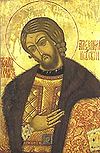
Military and explorers - Field marshals
- Soviet marshals
- Admirals
- Aviators
- Cosmonauts
Scientists and inventors - Aerospace engineers
- Astronomers and astrophysicists
- Biologists
- Chemists
- Earth scientists
- Electrical engineers
- IT developers
- Linguists and philologists
- Mathematicians
- Naval engineers
- Physicians and psychologists
- Physicists
- Weaponry makers
Artists and writers Sportspeople - Chess players
Categories:- Russia-related lists
- Soviet Union-related lists
- Heads of state of the Soviet Union
- Government of the Soviet Union
- Russian leaders
- Lists of heads of state
Wikimedia Foundation. 2010.

